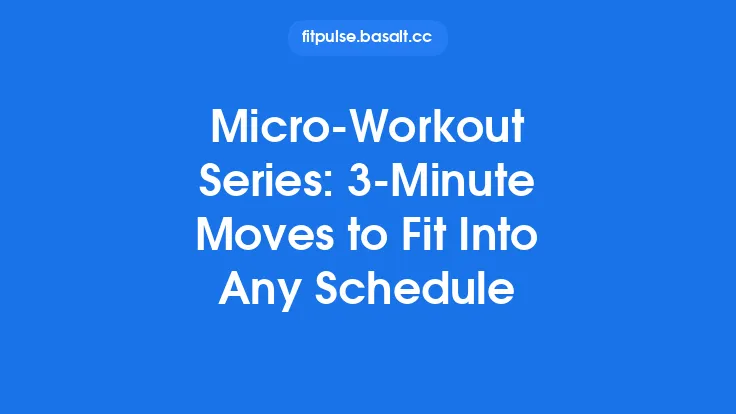Explosive power—often described as the ability to generate force quickly—is a cornerstone of athletic performance, from sprinting and jumping to striking and throwing. While traditional strength training relies heavily on barbells and machines, you can develop impressive power using just your bodyweight and a weighted vest. This approach is especially appealing for those who train at home, travel frequently, or simply prefer a minimalist setup. Below, we’ll explore the science behind explosive power, why a weighted vest is a game‑changer, the most effective bodyweight movements, and how to structure your training for consistent, long‑term gains.
Understanding Explosive Power
The Physiology of Speed and Force
Explosive power is the product of two variables: force (how much load you can move) and velocity (how fast you can move it). In biomechanical terms, power = force × velocity. Muscles generate force through the recruitment of motor units, and the speed of contraction is dictated by the type of muscle fibers engaged. Fast‑twitch (Type II) fibers are primed for rapid, high‑force output, while slow‑twitch (Type I) fibers excel at endurance.
The Role of the Stretch‑Shortening Cycle (SSC)
Most powerful movements—such as jumps, bounds, and plyometric push‑ups—rely on the stretch‑shortening cycle. During the eccentric (stretch) phase, elastic energy is stored in the muscle‑tendon complex. A rapid transition to the concentric (shortening) phase releases that stored energy, amplifying force production. Training that emphasizes a quick, explosive transition maximizes SSC efficiency.
Neuromuscular Adaptations
Repeated explosive training leads to:
- Increased motor unit firing frequency – the nervous system learns to fire muscle fibers more rapidly.
- Improved inter‑muscular coordination – synergistic muscles fire in a more synchronized pattern.
- Enhanced rate of force development (RFD) – the ability to reach peak force in a shorter time.
These adaptations are largely independent of hypertrophy; you can become more powerful without dramatically increasing muscle size.
Why a Weighted Vest Enhances Power Development
Adding Load Without Compromising Mobility
A weighted vest distributes mass evenly across the torso, preserving your natural range of motion. Unlike holding dumbbells or kettlebells, the vest allows you to perform full‑body, multi‑planar movements (e.g., jumps, burpees, hand‑stand push‑ups) without altering limb mechanics.
Overload Principle for Bodyweight Exercises
When you add weight, the same movement demands more force production. This overload forces the nervous system to recruit additional motor units, especially the high‑threshold fast‑twitch fibers crucial for power.
Progressive Loading in Small Increments
Weighted vests typically come in modular plates (e.g., 5 lb/2.3 kg increments). This granularity lets you fine‑tune the stimulus, ensuring you stay within the optimal power zone (roughly 30–50 % of your one‑rep max for many plyometric exercises).
Transfer to Real‑World Performance
Because the vest mimics the added mass of equipment (e.g., a football helmet, a backpack, or a combat loadout), the strength and power you develop translate directly to sport‑specific scenarios.
Key Bodyweight Movements for Power
Below are the most effective exercises for building explosive power while wearing a vest. Each movement emphasizes a rapid concentric phase and a brief, controlled eccentric phase to maximize SSC utilization.
| Exercise | Primary Muscles | Power Focus | Vest Load Recommendation |
|---|---|---|---|
| Depth Jumps | Quadriceps, glutes, calves | Vertical power | 10–20 % of body weight |
| Weighted Broad Jumps | Hip extensors, hamstrings, core | Horizontal power | 5–15 % of body weight |
| Plyometric Push‑Ups | Chest, triceps, anterior deltoids | Upper‑body power | 5–10 % of body weight |
| Weighted Box Jumps | Quads, glutes, calves | Explosive height | 10–20 % of body weight |
| Burpee‑to‑Jump | Full‑body, especially posterior chain | Conditioning + power | 5–15 % of body weight |
| Weighted Single‑Leg Bounds | Glutes, hamstrings, stabilizers | Unilateral power | 5–10 % of body weight |
| Hand‑Stand Push‑Up Explosions | Shoulders, triceps, core | Overhead power | 5–10 % of body weight (advanced) |
| Weighted Tuck Jumps | Quads, calves, core | Quick, repeated vertical power | 5–15 % of body weight |
Execution Tips
- Depth Jumps: Step off a 12‑inch box, land softly, and immediately explode upward. Contact time should be ≤ 0.2 seconds.
- Plyometric Push‑Ups: Lower to the floor, then push explosively so hands leave the ground. Aim for a 0.1‑second flight.
- Weighted Broad Jumps: Perform a controlled squat, swing arms, and launch forward. Land with knees slightly bent to absorb impact.
Programming the Vest for Power Gains
1. Determine Your Baseline Load
Start with a vest weight that adds 10 % of your body mass for lower‑body moves and 5 % for upper‑body moves. This provides enough stimulus without compromising technique.
2. Frequency & Volume
- Sessions per week: 2–3 dedicated power days, spaced at least 48 hours apart.
- Sets & Reps: 3–5 sets of 3–6 explosive reps per exercise. The low rep range preserves speed; the higher set count ensures sufficient neural stimulus.
3. Rest Intervals
Power training thrives on full recovery between sets. Rest 2–3 minutes for lower‑body plyometrics and 1.5–2 minutes for upper‑body movements. This allows ATP‑PCr stores to replenish, maintaining maximal force output.
4. Load Progression
Every 2–3 weeks, increase vest weight by 5 % of body mass (or the next modular plate). If you cannot maintain proper speed or technique, hold the current load until you can.
5. Deload Weeks
Every 4–6 weeks, schedule a deload: reduce vest weight by 50 % and cut volume by 30 %. This mitigates central nervous system fatigue while preserving adaptations.
6. Integration with Skill Work
If you practice sport‑specific skills (e.g., sprint starts, vertical jumps), perform them after your power session when the nervous system is primed. Keep skill volume low to avoid excessive fatigue.
Sample Workouts
Workout A – Lower‑Body Power Focus
- Dynamic Warm‑up (5 min): Leg swings, hip circles, ankle mobility drills.
- Depth Jumps – 4 × 4 reps (vest 15 % BW)
- Weighted Broad Jumps – 3 × 5 reps (vest 10 % BW)
- Weighted Single‑Leg Bounds – 3 × 6 reps per leg (vest 8 % BW)
- Weighted Box Jumps – 4 × 3 reps (vest 12 % BW)
- Cool‑down (5 min): Light jogging, static quad/hamstring stretches.
Workout B – Upper‑Body & Full‑Body Power
- Dynamic Warm‑up (5 min): Arm circles, scapular push‑ups, band pull‑aparts (light).
- Plyometric Push‑Ups – 5 × 5 reps (vest 7 % BW)
- Weighted Burpee‑to‑Jump – 4 × 6 reps (vest 10 % BW)
- Hand‑Stand Push‑Up Explosions – 3 × 3 reps (vest 5 % BW, advanced)
- Weighted Tuck Jumps – 4 × 5 reps (vest 10 % BW)
- Cool‑down (5 min): Shoulder mobility flow, chest stretch.
Adjust the number of sets/reps based on your current conditioning. The key is to keep each rep explosive and controlled.
Technique Tips for Maximum Power Output
- Ground Contact Time: Aim for ≤ 0.2 seconds on landing before the next jump. Use a timer or video analysis to monitor.
- Arm Swing: In lower‑body jumps, a vigorous arm swing adds momentum and improves vertical height. Keep the swing coordinated with the leg drive.
- Hip Extension: Focus on driving the hips forward and upward, not just the knees. Think “hip thrust” rather than “knee bend.”
- Breathing: Exhale sharply during the concentric (explosive) phase; inhale during the eccentric phase. This helps maintain intra‑abdominal pressure and core stability.
- Foot Placement: For jumps, land on the balls of the feet to allow a quick rebound. For push‑ups, keep hands slightly wider than shoulder width to maximize chest activation.
- Progressive Overload Mindset: Power is a neural quality; small increments in load can produce large gains if speed is preserved.
Recovery and Adaptation
- Sleep: 7–9 hours per night supports neural recovery and hormone balance (testosterone, growth hormone).
- Nutrition: While not the focus of this article, adequate protein (≈ 1.6 g/kg body weight) and carbohydrate intake help replenish glycogen and support repair.
- Active Recovery: Light mobility work, foam rolling, or low‑intensity cycling on off‑days promotes blood flow without taxing the CNS.
- Monitoring Fatigue: If you notice a drop in jump height or push‑up explosiveness across a session, consider extending rest intervals or reducing vest load temporarily.
Common Mistakes and How to Fix Them
| Mistake | Why It Undermines Power | Fix |
|---|---|---|
| Using Too Heavy a Vest | Slows movement speed, reduces SSC efficiency, increases injury risk. | Start light (5–10 % BW). Only increase when you can maintain explosive tempo. |
| Long Eccentric Phase | Diminishes stored elastic energy, lowers RFD. | Keep the descent quick (≈ 0.5 seconds) and transition to the concentric phase within 0.2 seconds. |
| Neglecting Warm‑Up | Muscles and tendons are less compliant, leading to poor force transfer. | Perform a dynamic warm‑up targeting the movement pattern (e.g., leg swings before jumps). |
| Insufficient Rest Between Sets | Incomplete ATP‑PCr replenishment, causing reduced power output. | Rest 2–3 minutes for lower‑body, 1.5–2 minutes for upper‑body. |
| Poor Landing Mechanics | Excessive joint stress, risk of knee/ankle injury. | Land softly on the mid‑foot, knees slightly bent, hips back. |
| Ignoring Core Stability | Core collapse reduces force transmission from lower to upper body. | Engage the core (draw the belly button toward the spine) throughout each rep. |
Frequently Asked Questions
Q: How long will it take to see noticeable power gains?
A: Most individuals experience measurable improvements in jump height or push‑up explosiveness within 4–6 weeks of consistent training (2–3 sessions per week) when following progressive overload.
Q: Can I use a weighted vest for endurance training?
A: Yes, but the focus shifts. For power, keep reps low and rest long. For endurance, increase reps and reduce rest, but this dilutes the power stimulus.
Q: Is a weighted vest safe for beginners?
A: Absolutely, provided you start with a light load (≤ 5 % of body weight) and master the movement patterns without the vest first. Gradually add weight as technique improves.
Q: Should I combine this training with traditional weightlifting?
A: Combining both can be synergistic. If you lift heavy (e.g., squats, deadlifts) on separate days, you’ll develop both maximal strength and explosive power.
Q: How do I know if I’m overtraining?
A: Persistent fatigue, declining performance, irritability, and trouble sleeping are red flags. Incorporate deload weeks and ensure adequate recovery.
Closing Thoughts
Building explosive power doesn’t require a full gym. By leveraging the simplicity of a weighted vest and the versatility of bodyweight movements, you can create a potent, equipment‑light program that targets the neuromuscular qualities essential for speed, jump, and overall athleticism. Focus on speed first, progressive overload second, and quality movement throughout. With consistent effort, proper load management, and attention to recovery, you’ll see tangible improvements in how quickly and forcefully you can move—whether on the track, the court, or in everyday life.





